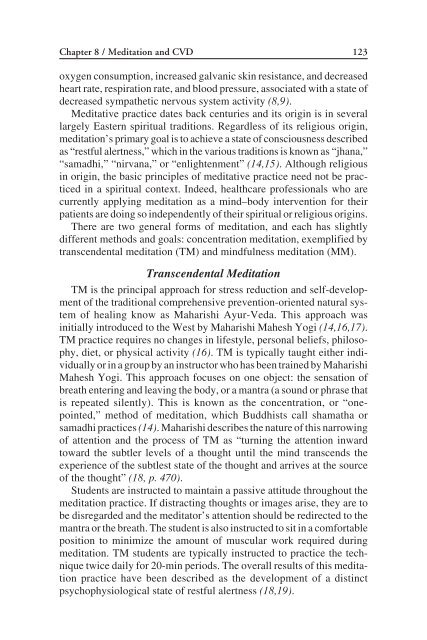Complementary Alternative Cardiovascular Medicine
Complementary Alternative Cardiovascular Medicine
Complementary Alternative Cardiovascular Medicine
You also want an ePaper? Increase the reach of your titles
YUMPU automatically turns print PDFs into web optimized ePapers that Google loves.
Chapter 8 / Meditation and CVD 123<br />
oxygen consumption, increased galvanic skin resistance, and decreased<br />
heart rate, respiration rate, and blood pressure, associated with a state of<br />
decreased sympathetic nervous system activity (8,9).<br />
Meditative practice dates back centuries and its origin is in several<br />
largely Eastern spiritual traditions. Regardless of its religious origin,<br />
meditation’s primary goal is to achieve a state of consciousness described<br />
as “restful alertness,” which in the various traditions is known as “jhana,”<br />
“samadhi,” “nirvana,” or “enlightenment” (14,15). Although religious<br />
in origin, the basic principles of meditative practice need not be practiced<br />
in a spiritual context. Indeed, healthcare professionals who are<br />
currently applying meditation as a mind–body intervention for their<br />
patients are doing so independently of their spiritual or religious origins.<br />
There are two general forms of meditation, and each has slightly<br />
different methods and goals: concentration meditation, exemplified by<br />
transcendental meditation (TM) and mindfulness meditation (MM).<br />
Transcendental Meditation<br />
TM is the principal approach for stress reduction and self-development<br />
of the traditional comprehensive prevention-oriented natural system<br />
of healing know as Maharishi Ayur-Veda. This approach was<br />
initially introduced to the West by Maharishi Mahesh Yogi (14,16,17).<br />
TM practice requires no changes in lifestyle, personal beliefs, philosophy,<br />
diet, or physical activity (16). TM is typically taught either individually<br />
or in a group by an instructor who has been trained by Maharishi<br />
Mahesh Yogi. This approach focuses on one object: the sensation of<br />
breath entering and leaving the body, or a mantra (a sound or phrase that<br />
is repeated silently). This is known as the concentration, or “onepointed,”<br />
method of meditation, which Buddhists call shamatha or<br />
samadhi practices (14). Maharishi describes the nature of this narrowing<br />
of attention and the process of TM as “turning the attention inward<br />
toward the subtler levels of a thought until the mind transcends the<br />
experience of the subtlest state of the thought and arrives at the source<br />
of the thought” (18, p. 470).<br />
Students are instructed to maintain a passive attitude throughout the<br />
meditation practice. If distracting thoughts or images arise, they are to<br />
be disregarded and the meditator’s attention should be redirected to the<br />
mantra or the breath. The student is also instructed to sit in a comfortable<br />
position to minimize the amount of muscular work required during<br />
meditation. TM students are typically instructed to practice the technique<br />
twice daily for 20-min periods. The overall results of this meditation<br />
practice have been described as the development of a distinct<br />
psychophysiological state of restful alertness (18,19).


